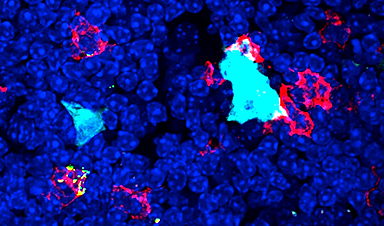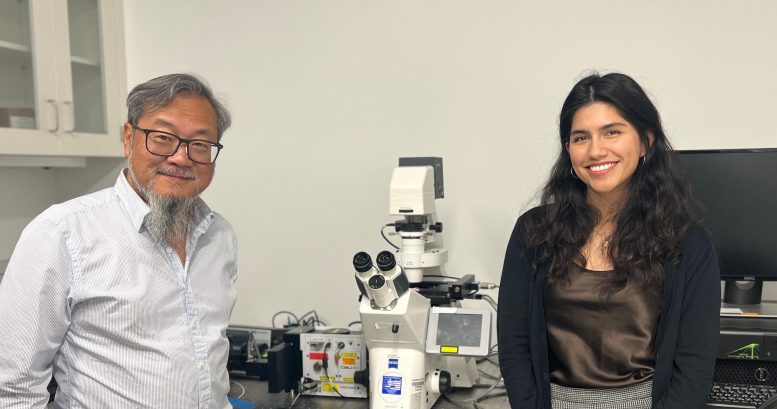Biomedical scientists from UC Riverside state that the cells resemble M cells found in the gut and airways.
It came as a surprise to Professor David Lo and his graduate student Diana Del Castillo when they were recently consulted by researchers in Israel for their expertise on specialized cells called Microfold cells, or M cells, which are mostly known for their presence in the intestinal epithelium. The Israeli group had identified similar cells in the thymus, an organ located just above the heart that makes lymphocytes — white blood cells that play an important role in the immune system and protect the body against infection.
Lo, a distinguished professor of biomedical sciences in the UC Riverside School of Medicine, and Del Castillo, who are co-authors on the research paper published in Nature, confirmed the newly discovered cells in the thymus are just like M cells. Acting like gatekeepers, M cells are specialized antigen-delivery cells for the immune system in organs like the intestine and lungs. They play a key role in the development of the body’s immune system.
The researchers at the Weizmann Institute of Science in Israel, led by Jakub Abramson, initiated the mouse study on the thymic epithelium before contacting Lo, whose research interests include understanding how M cells in the gut and airways work to build our immune system.
“I have been working on these cells for several years, so when the Israeli team contacted me, I was intrigued,” Lo said. “I learned this group had been doing studies on the cellular architecture of stromal cells — cells that make up certain types of connective tissue — in the thymus and, using a new advanced method, had discovered a population of cells much like the M cells we see in the gut and airways. In my own research, I had simply never thought to look for M cells in the thymus.”
Fortuitously for the Israeli scientists, Del Castillo, under Lo’s guidance, had been studying mucosal tissues — tissues that line some of the body’s canals and organs — in mice in the lab and was able to answer several questions, such as where in the thymus the newly discovered cells are located and what they are doing there.
The Unique Nature of Thymic M Cells
“These particular M cells are limited to a specific region in the thymus and have unique associations with different cell types and functions,” Del Castillo said. “Questions these cells have already prompted include how similar are they to M cells elsewhere in the body and what is different about where they have been found.”
Lo explained that for many years the thymus has been a tissue of interest to immunologists because most of the immune system’s development is centered and dependent on the thymus.
“It’s still an ongoing deep puzzle that continues to attract interest,” he said. “The thymus offers clues to how the immune system got its start. This complicated organ, with so many different stromal cell types and interactions, is responsible for producing lymphocytes that protect us from infection.”
According to Lo, the newly discovered M cells are extremely similar to the M cells seen in the gut and airways.
“But the thymic M cells have different developmental origins, which is an interesting puzzle in itself,” he said. “After they develop, they look very much like the ones we have been studying in the gut. As we know, M cells capture viruses and bugs that enter the airways and hand them off to the immune system, which then responds to the infectious agents. Are the M cells doing the same thing in the thymus in terms of organization and function? That’s what we would like to know.”
Exploring the Function of Thymic M Cells
Del Castillo, who is working toward her doctoral degree in biomedical sciences, used genetically engineered mice to tackle the questions from the Israeli researchers.
“We found the new cells were scattered in the medullary region of the thymus,” she said. “This has interesting implications in terms of the role and compartmentalization of the thymus, such as how these cells may function to regulate lymphocyte training within this organ.”
Lo and Del Castillo were surprised to find that many steps involved in shaping an immune response in various parts of the body seem to be echoed in the thymus.
“It is fascinating to see that many of these early cell interactions and development we have studied closely in the peripheral immune system take place in the thymus,” Lo said. “We had not anticipated to see these interactions here. It’s like watching a short video in the thymus about what is happening big-scale out in the periphery.”
The thymus also ensures that lymphocytes do not accidentally attack our own tissues; the thymic medulla is where these decisions are made, the UCR scientists said.
“The newly discovered M cells are part of this decision-making process,” Del Castillo said. “The production of antibodies in the peripheral immune system to fight off infectious organisms involves several steps and many cells interacting with each other. What is fascinating is that some of these interactions are recapitulated in the early stages of the development of the thymic M cells.”
According to Lo, the thymic M cells could be seen as being trained to function later, when needed, in the periphery in such a way that they are ready to communicate and interact with other cells.
“The thymus is complicated because it creates a whole functional immune system and repertoire, and we know many component parts play a role in its performance,” he said. “We didn’t expect M cells to even show up in the thymus. This is, therefore, a satisfying discovery because it is so clearly connected to similar processes happening in the gut and airways, which is where 60-70% of our infectious agents enter our bodies.”
Reference: “Thymic mimetic cells function beyond self-tolerance” by Tal Givony, Dena Leshkowitz, Diana Del Castillo, Shir Nevo, Noam Kadouri, Bareket Dassa, Yael Gruper, Razi Khalaila, Osher Ben-Nun, Tom Gome, Jan Dobeš, Shifra Ben-Dor, Merav Kedmi, Hadas Keren-Shaul, Rebecca Heffner-Krausz, Ziv Porat, Ofra Golani, Yoseph Addadi, Ori Brenner, David D. Lo, Yael Goldfarb and Jakub Abramson, 6 September 2023, Nature.
DOI: 10.1038/s41586-023-06512-8
News
The Brain’s Strange Way of Computing Could Explain Consciousness
Consciousness may emerge not from code, but from the way living brains physically compute. Discussions about consciousness often stall between two deeply rooted viewpoints. One is computational functionalism, which holds that cognition can be [...]
First breathing ‘lung-on-chip’ developed using genetically identical cells
Researchers at the Francis Crick Institute and AlveoliX have developed the first human lung-on-chip model using stem cells taken from only one person. These chips simulate breathing motions and lung disease in an individual, [...]
Cell Membranes May Act Like Tiny Power Generators
Living cells may generate electricity through the natural motion of their membranes. These fast electrical signals could play a role in how cells communicate and sense their surroundings. Scientists have proposed a new theoretical [...]
This Viral RNA Structure Could Lead to a Universal Antiviral Drug
Researchers identify a shared RNA-protein interaction that could lead to broad-spectrum antiviral treatments for enteroviruses. A new study from the University of Maryland, Baltimore County (UMBC), published in Nature Communications, explains how enteroviruses begin reproducing [...]
New study suggests a way to rejuvenate the immune system
Stimulating the liver to produce some of the signals of the thymus can reverse age-related declines in T-cell populations and enhance response to vaccination. As people age, their immune system function declines. T cell [...]
Nerve Damage Can Disrupt Immunity Across the Entire Body
A single nerve injury can quietly reshape the immune system across the entire body. Preclinical research from McGill University suggests that nerve injuries may lead to long-lasting changes in the immune system, and these [...]
Fake Science Is Growing Faster Than Legitimate Research, New Study Warns
New research reveals organized networks linking paper mills, intermediaries, and compromised academic journals Organized scientific fraud is becoming increasingly common, ranging from fabricated research to the buying and selling of authorship and citations, according [...]
Scientists Unlock a New Way to Hear the Brain’s Hidden Language
Scientists can finally hear the brain’s quietest messages—unlocking the hidden code behind how neurons think, decide, and remember. Scientists have created a new protein that can capture the incoming chemical signals received by brain [...]
Does being infected or vaccinated first influence COVID-19 immunity?
A new study analyzing the immune response to COVID-19 in a Catalan cohort of health workers sheds light on an important question: does it matter whether a person was first infected or first vaccinated? [...]
We May Never Know if AI Is Conscious, Says Cambridge Philosopher
As claims about conscious AI grow louder, a Cambridge philosopher argues that we lack the evidence to know whether machines can truly be conscious, let alone morally significant. A philosopher at the University of [...]
AI Helped Scientists Stop a Virus With One Tiny Change
Using AI, researchers identified one tiny molecular interaction that viruses need to infect cells. Disrupting it stopped the virus before infection could begin. Washington State University scientists have uncovered a method to interfere with a key [...]
Deadly Hospital Fungus May Finally Have a Weakness
A deadly, drug-resistant hospital fungus may finally have a weakness—and scientists think they’ve found it. Researchers have identified a genetic process that could open the door to new treatments for a dangerous fungal infection [...]
Fever-Proof Bird Flu Variant Could Fuel the Next Pandemic
Bird flu viruses present a significant risk to humans because they can continue replicating at temperatures higher than a typical fever. Fever is one of the body’s main tools for slowing or stopping viral [...]
What could the future of nanoscience look like?
Society has a lot to thank for nanoscience. From improved health monitoring to reducing the size of electronics, scientists’ ability to delve deeper and better understand chemistry at the nanoscale has opened up numerous [...]
Scientists Melt Cancer’s Hidden “Power Hubs” and Stop Tumor Growth
Researchers discovered that in a rare kidney cancer, RNA builds droplet-like hubs that act as growth control centers inside tumor cells. By engineering a molecular switch to dissolve these hubs, they were able to halt cancer [...]
Platelet-inspired nanoparticles could improve treatment of inflammatory diseases
Scientists have developed platelet-inspired nanoparticles that deliver anti-inflammatory drugs directly to brain-computer interface implants, doubling their effectiveness. Scientists have found a way to improve the performance of brain-computer interface (BCI) electrodes by delivering anti-inflammatory drugs directly [...]






















